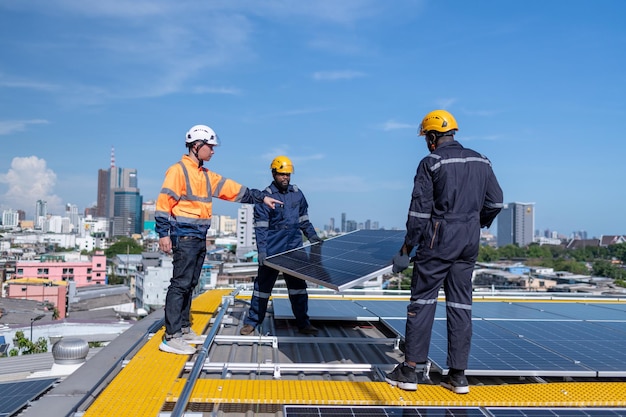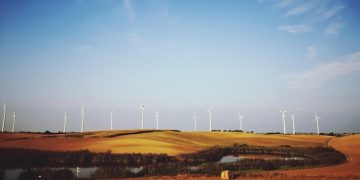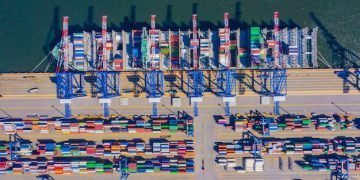The Future of Renewable Energy in the US: Investments, Policy, and Growth

The future of renewable energy in the US is heavily influenced by government investments and policy changes aimed at fostering growth and sustainability in the sector.
The United States is at a pivotal moment in its energy history, with the transition to renewable energy sources gaining unprecedented momentum. The future of renewable energy in the US: Government Investments and Policy Changes is a complex interplay of technological advancements, economic incentives, and policy decisions that will shape the nation’s energy landscape for decades to come. This article delves into the key factors driving this transformation, examining the impact of government investments and policy changes on the growth and adoption of renewable energy sources.
Government Investments in Renewable Energy
Government investments play a crucial role in accelerating the development and deployment of renewable energy technologies. These investments can take various forms, including direct funding for research and development, tax incentives for renewable energy projects, and loan guarantees to help finance large-scale renewable energy infrastructure.
These investments are critical for overcoming the initial barriers to entry for renewable energy technologies, such as high upfront costs and technological uncertainties. By providing financial support, the government can help reduce the cost of renewable energy, making it more competitive with traditional fossil fuels and encouraging wider adoption.
Federal Funding Programs
Several federal funding programs support renewable energy development in the US. The Department of Energy (DOE) offers grants, loans, and other financial assistance through various programs, such as the Office of Energy Efficiency and Renewable Energy (EERE). These programs focus on a wide range of renewable energy technologies, including solar, wind, geothermal, hydropower, and bioenergy.
The Investment Tax Credit (ITC) and the Production Tax Credit (PTC) are two major tax incentives that have significantly boosted renewable energy deployment. The ITC provides a tax credit for a percentage of the cost of solar energy systems, while the PTC offers a tax credit for each kilowatt-hour of electricity generated by qualified renewable energy facilities.
State-Level Initiatives
In addition to federal programs, many states have implemented their own initiatives to support renewable energy. These initiatives can include renewable portfolio standards (RPS), which require utilities to generate a certain percentage of their electricity from renewable sources, as well as state-level tax incentives, grants, and loans.
- California’s Renewable Portfolio Standard: Mandates 60% renewable energy by 2030.
- New York’s Clean Energy Standard: Aims for 70% renewable electricity by 2030.
- Massachusetts’ Green Communities Act: Supports local renewable energy projects.
- Texas’ Competitive Renewable Energy Zones: Facilitates wind energy transmission.

State-level initiatives often play a critical role in driving renewable energy deployment, particularly in states with ambitious climate goals and supportive policy environments. These initiatives can create local markets for renewable energy, attract private investment, and stimulate job growth in the renewable energy sector.
Government investments in renewable energy are essential for driving innovation, reducing costs, and accelerating the transition to a cleaner energy future. These investments, combined with supportive policies, can help unlock the full potential of renewable energy and create a more sustainable and resilient energy system for the United States.
Key Policy Changes Driving Renewable Energy Growth
Policy changes are another critical factor influencing the future of renewable energy in the US. These changes can include federal and state laws, regulations, and executive orders that promote or incentivize the development and deployment of renewable energy technologies.
Supportive policies can create a level playing field for renewable energy, reduce regulatory barriers, and provide long-term certainty for investors. This, in turn, can help drive down the cost of renewable energy, attract private investment, and accelerate the transition to a cleaner energy future.
The Inflation Reduction Act (IRA)
The Inflation Reduction Act (IRA), enacted in 2022, is a landmark piece of legislation that includes significant investments and policy changes to support renewable energy. The IRA provides long-term extensions and expansions of the ITC and PTC, as well as new tax credits for energy storage, clean hydrogen, and carbon capture.
The IRA is expected to have a transformative impact on the renewable energy sector, driving significant growth in solar, wind, and other renewable energy technologies. The law is also expected to create millions of jobs and reduce greenhouse gas emissions, helping the US meet its climate goals. The Act also aims to lower energy costs for families and businesses, while creating jobs and reducing pollution.
Federal Energy Regulatory Commission (FERC) Actions
The Federal Energy Regulatory Commission (FERC) plays a critical role in regulating the transmission of electricity and ensuring fair access to the grid for renewable energy projects. FERC has taken several actions in recent years to remove barriers to renewable energy integration, such as streamlining the interconnection process and promoting regional transmission planning.
- Order No. 2222: Enables distributed energy resources (DERs) to participate in wholesale markets.
- Transmission Planning Rule: Requires long-term regional transmission planning to accommodate renewable energy.
- Interconnection Reforms: Aims to streamline the process for connecting renewable energy projects to the grid.
FERC’s actions are essential for ensuring that renewable energy projects can access the grid and compete fairly in the electricity market. These actions can help unlock the full potential of renewable energy and create a more reliable and resilient energy system.

Policy changes are a powerful tool for driving renewable energy growth. The Inflation Reduction Act and FERC’s actions are just two examples of how supportive policies can create a more favorable environment for renewable energy and accelerate the transition to a cleaner energy future. As policies continue to evolve, the renewable energy sector is poised for further growth and innovation.
Technological Advancements in Renewable Energy
Technological advancements are continuously improving the efficiency, reliability, and affordability of renewable energy technologies. These advancements are critical for making renewable energy more competitive with traditional fossil fuels and enabling wider adoption.
Innovations in areas such as solar panel efficiency, wind turbine design, and energy storage are driving down the cost of renewable energy and improving its performance. These advancements are making renewable energy a more viable and attractive option for consumers and businesses.
Solar Technology Innovations
Solar technology has made significant strides in recent years, with improvements in solar panel efficiency, durability, and cost. Perovskite solar cells, for example, are a promising new technology that could potentially achieve higher efficiencies at a lower cost than traditional silicon-based solar cells.
Bifacial solar panels, which can generate electricity from both sides, are also gaining popularity. These panels can increase energy production by up to 30% compared to traditional monofacial panels.
Wind Energy Advancements
Wind energy technology is also advancing rapidly, with improvements in wind turbine design, materials, and control systems. Taller wind turbines with longer blades can capture more wind energy, while advanced control systems can optimize turbine performance and reduce wear and tear. Floating offshore wind turbines, which can be deployed in deeper waters, are opening up new areas for wind energy development.
These advancements are making wind energy a more reliable and cost-effective source of electricity. As wind turbine technology continues to improve, wind energy is poised to play an even larger role in the US energy mix.
- Larger turbines: Enhancing energy capture.
- Advanced materials: Improving durability and performance.
- Floating turbines: Accessing offshore wind resources.
- Predictive maintenance: Reducing downtime and costs.
Technological advancements are driving down the cost of renewable energy and improving its performance. Innovations in solar, wind, and energy storage are making renewable energy a more viable and attractive option for consumers and businesses. As technology continues to evolve, the renewable energy sector is poised for further growth and innovation.
Challenges and Opportunities for Renewable Energy
Despite the significant progress made in recent years, the renewable energy sector still faces several challenges. These challenges include high upfront costs, intermittency issues, grid integration challenges, and regulatory barriers.
However, these challenges also present significant opportunities for innovation and growth. By addressing these challenges, the renewable energy sector can unlock its full potential and create a more sustainable and resilient energy system.
Intermittency and Energy Storage
One of the main challenges facing renewable energy is intermittency, the fact that solar and wind energy are not always available when needed. This can create challenges for grid operators, who must ensure a reliable supply of electricity at all times.
Energy storage technologies, such as batteries, pumped hydro storage, and thermal energy storage, can help address the intermittency issue by storing excess renewable energy and releasing it when needed. Advancements in energy storage technology are making it more affordable and efficient, paving the way for greater integration of renewable energy into the grid.
Grid Modernization
Modernizing the electric grid is another critical challenge for renewable energy. The current grid was designed for a centralized system with large power plants located far from population centers. Integrating distributed renewable energy sources, such as rooftop solar panels, requires a more flexible and intelligent grid.
Grid modernization efforts include investments in advanced sensors, data analytics, and control systems, which can help grid operators manage the flow of electricity more efficiently and reliably. Smart grids can also enable greater participation by consumers, who can respond to price signals and adjust their energy consumption accordingly.
- Smart grids: Enhancing grid flexibility and reliability.
- Advanced sensors: Monitoring grid conditions in real-time.
- Data analytics: Optimizing grid operations.
- Demand response: Engaging consumers in grid management.
The renewable energy sector faces several challenges, including intermittency and grid integration issues. However, these challenges also present significant opportunities for innovation and growth. By addressing these challenges, the renewable energy sector can unlock its full potential and create a more sustainable and resilient energy system.
The Economic Impact of Renewable Energy
The growth of renewable energy has significant economic implications for the US. These include job creation, economic development, and energy independence.
The renewable energy sector is a major source of job creation, employing millions of people in manufacturing, construction, installation, and maintenance. Renewable energy projects can also stimulate economic development in rural areas, where many renewable energy resources are located.
Job Creation
The renewable energy sector is a major source of job creation in the US. Solar and wind energy, in particular, are creating jobs at a rapid pace, as companies invest in new manufacturing facilities and renewable energy projects. According to the US Bureau of Labor Statistics, solar photovoltaic installers and wind turbine technicians are projected to be two of the fastest-growing occupations over the next decade.
These jobs are often well-paying and require a range of skills, from engineering and construction to sales and marketing. The growth of the renewable energy sector is creating new opportunities for workers and helping to build a more diverse and inclusive economy.
Economic Development
Renewable energy projects can also stimulate economic development in rural areas. Many renewable energy resources, such as wind and solar, are located in rural areas, where they can provide a new source of revenue for landowners and local communities.
Renewable energy projects can also attract new businesses and industries to rural areas, creating jobs and boosting local economies. In addition, renewable energy projects can help diversify the economy of rural areas, reducing their dependence on traditional industries such as agriculture and mining.
- Rural development: Creating revenue streams for landowners.
- New businesses: Attracting industries to rural areas.
- Diversified economy: Reducing dependence on traditional industries.
- Investment opportunities: Stimulating local economies.
The growth of renewable energy has significant economic implications for the US. The renewable energy sector is creating jobs, stimulating economic development, and enhancing energy independence. As renewable energy continues to grow, it is poised to play an even larger role in the US economy.
The Future Outlook for Renewable Energy in the US
The future outlook for renewable energy in the US is bright, with continued growth expected in the coming years. Government investments, policy changes, and technological advancements are all driving the transition to a cleaner energy future.
Renewable energy is poised to play an increasingly important role in the US energy mix, helping to reduce greenhouse gas emissions, create jobs, and enhance energy security. As renewable energy technologies continue to improve and become more affordable, they are poised to become the dominant source of electricity in the US.
Long-Term Growth Projections
Long-term growth projections for renewable energy in the US are highly optimistic. The US Energy Information Administration (EIA) projects that renewable energy will be the fastest-growing source of electricity generation over the next 30 years, accounting for nearly half of all electricity generation by 2050.
Other organizations, such as the International Renewable Energy Agency (IRENA), also project significant growth in renewable energy, with solar and wind energy expected to lead the way. These projections reflect the growing competitiveness of renewable energy, as well as the increasing urgency to address climate change.
The Path Forward
The path forward for renewable energy in the US is clear. Continued government investments, policy support, and technological innovation are essential for driving the transition to a cleaner energy future. By working together, the government, industry, and consumers can unlock the full potential of renewable energy and create a more sustainable and prosperous future for all.
This involves increasing collaboration between federal, state, and local governments. Streamlining regulations and permitting processes to make it easier to develop and deploy projects. Educating the public about the benefits of renewable energy. Working together to advance the transition to a cleaner energy future, the US can create a more sustainable, prosperous, and equitable society for all.
| Key Point | Brief Description |
|---|---|
| ⚡ Government Investments | Funding and tax incentives drive renewable energy projects. |
| 📜 Policy Changes | IRA and FERC actions promote renewable energy integration. |
| 💡 Tech Advances | Innovations boost efficiency and lower costs for renewables. |
| 🌎 Economic Impact | Job creation and rural development driven by renewables. |
Frequently Asked Questions
▼
Government plays a crucial role through investments, incentives, and policies. These support research, lower costs, and create a stable market for renewable energy technologies, fostering innovation and growth.
▼
The Inflation Reduction Act provides long-term tax credits and incentives for renewable energy projects. This is intended to drive growth in solar, wind, and other renewables, supporting job creation and emissions reduction.
▼
Intermittency (variability of supply) and grid integration are key challenges. Energy storage solutions and grid modernization efforts are crucial for ensuring a reliable and efficient integration of renewable sources.
▼
Renewable energy creates jobs in manufacturing, installation, and maintenance. It also stimulates economic development in rural areas where renewable resources are abundant, boosting local economies.
▼
The future looks promising, with continued growth expected. Projections indicate that renewable energy will become a dominant source of electricity in the coming decades, driven by technology, policy, and economic factors.
Conclusion
The trajectory of renewable energy in the US is shaped by a confluence of government actions, policy shifts, and technological progress. As investments increase and policies become more supportive, renewable energy is expected to play an increasingly significant role in the nation’s energy mix, contributing to a cleaner, more sustainable, and economically vibrant future.





